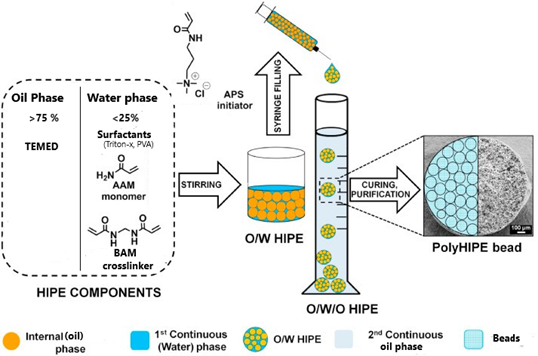
Synthesis of Hierarchically Porous Emulsion-Templated Polymer Beads and Their Nanocomposites for Heterogeneous Catalysis and Environmental Remediation
Abstract:
Emulsion templating is a versatile method for producing highly porous organic polymers, inorganic materials, and inorganic-organic composites with an elegant framework, tailored morphology, and unique properties for applications in tissue engineering, electrochemical technologies, catalysis, and environmental remediations. The scope and performance of emulsion templated porous materials/composites are severely limited by technical issues related to mechanical strength, which hinder their industrial-scale manufacturing for real-world applications, particularly in heterogeneous catalysis. To address this problem, we have synthesized hierarchically macroporous polyacrylamide beads by Oil in Water in Oil (O/W/O) emulsion polymerization. For this purpose, the oil phase containing TEMED is gradually added to the aqueous phase containing a monomer (acrylamide, AM), crosslinker (bisacrylamide, BAM), surfactant (Triton-X), and co-surfactant (PVA) to form a stable high internal phase emulsion (HIPE). The polymerization is initiated by adding a small amount of initiator (ammonium persulphate, APS) to form polyHIPE, which is then added to sedimentation medium (hot oil) and baked for 3 h to form polyacrylamide beads, followed by washing in order to remove the internal phase. After drying, the resulting polyacrylamide beads were then loaded with various polyoxometalates (POMs) by simply soaking the beads into POMs precursors followed by drying and gelation. In addition, we plan to use the PAM beads as a template for making porous metal oxides beads for environmental applications. For this purpose, we used an exo-templating approach to produce hierarchically porous TiO2 beads by incorporating the TiO2 sol into a macroporous polyacrylamide scaffold, followed by gelation, drying, and calcination. The resulting hierarchically porous TiO2 beads were loaded with various POMs by dipping the POMs precursors into the TiO2 beads, followed by nucleation and drying. All these newly synthesized catalysts are being characterized by SEM, EDX, powder-XRD, BET, FT-IR, and TGA and meanwhile also being evaluated for heterogeneous catalysis and photocatalytic degradation of organic pollutants such as textile dyes. In this presentation, in addition to the project introduction, I will present the preliminary results in this regard.
Thesis committee:
- Dr. Irshad Hussain (Supervisor)
- Dr. Salman Noshear Arshad (Thesis Committee Member)
- Dr. Falak Sher (Thesis Committee Member)

